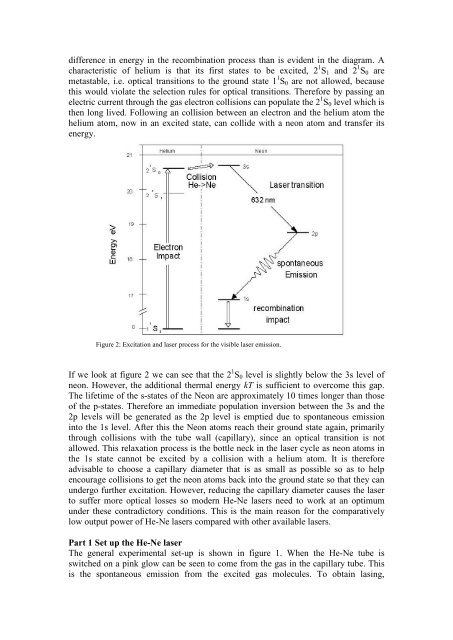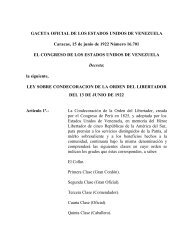Create successful ePaper yourself
Turn your PDF publications into a flip-book with our unique Google optimized e-Paper software.
difference in energy in the recombination process than is evident in the diagram. A<br />
characteristic of helium is that its first states to be excited, 2 1 S1 and 2 1 S0 are<br />
metastable, i.e. optical transitions to the ground state 1 1 S0 are not allowed, because<br />
this would violate the selection rules for optical transitions. Therefore by passing an<br />
electric current through the gas electron collisions can populate the 2 1 S0 level which is<br />
then long lived. Following an collision between an electron and the helium atom the<br />
helium atom, now in an excited state, can collide with a neon atom and transfer its<br />
energy.<br />
Figure 2: Excitation and laser process for the visible laser emission.<br />
If we look at figure 2 we can see that the 2 1 S0 level is slightly below the 3s level of<br />
neon. However, the additional thermal energy kT is sufficient to overcome this gap.<br />
The lifetime of the s-states of the <strong>Neon</strong> are approximately 10 times longer than those<br />
of the p-states. Therefore an immediate population inversion between the 3s and the<br />
2p levels will be generated as the 2p level is emptied due to spontaneous emission<br />
into the 1s level. After this the <strong>Neon</strong> atoms reach their ground state again, primarily<br />
through collisions with the tube wall (capillary), since an optical transition is not<br />
allowed. This relaxation process is the bottle neck in the laser cycle as neon atoms in<br />
the 1s state cannot be excited by a collision with a helium atom. It is therefore<br />
advisable to choose a capillary diameter that is as small as possible so as to help<br />
encourage collisions to get the neon atoms back into the ground state so that they can<br />
undergo further excitation. However, reducing the capillary diameter causes the laser<br />
to suffer more optical losses so modern He-Ne lasers need to work at an optimum<br />
under these contradictory conditions. This is the main reason for the comparatively<br />
low output power of He-Ne lasers compared with other available lasers.<br />
Part 1 Set up the He-Ne laser<br />
The general experimental set-up is shown in figure 1. When the He-Ne tube is<br />
switched on a pink glow can be seen to come from the gas in the capillary tube. This<br />
is the spontaneous emission from the excited gas molecules. To obtain lasing,

















